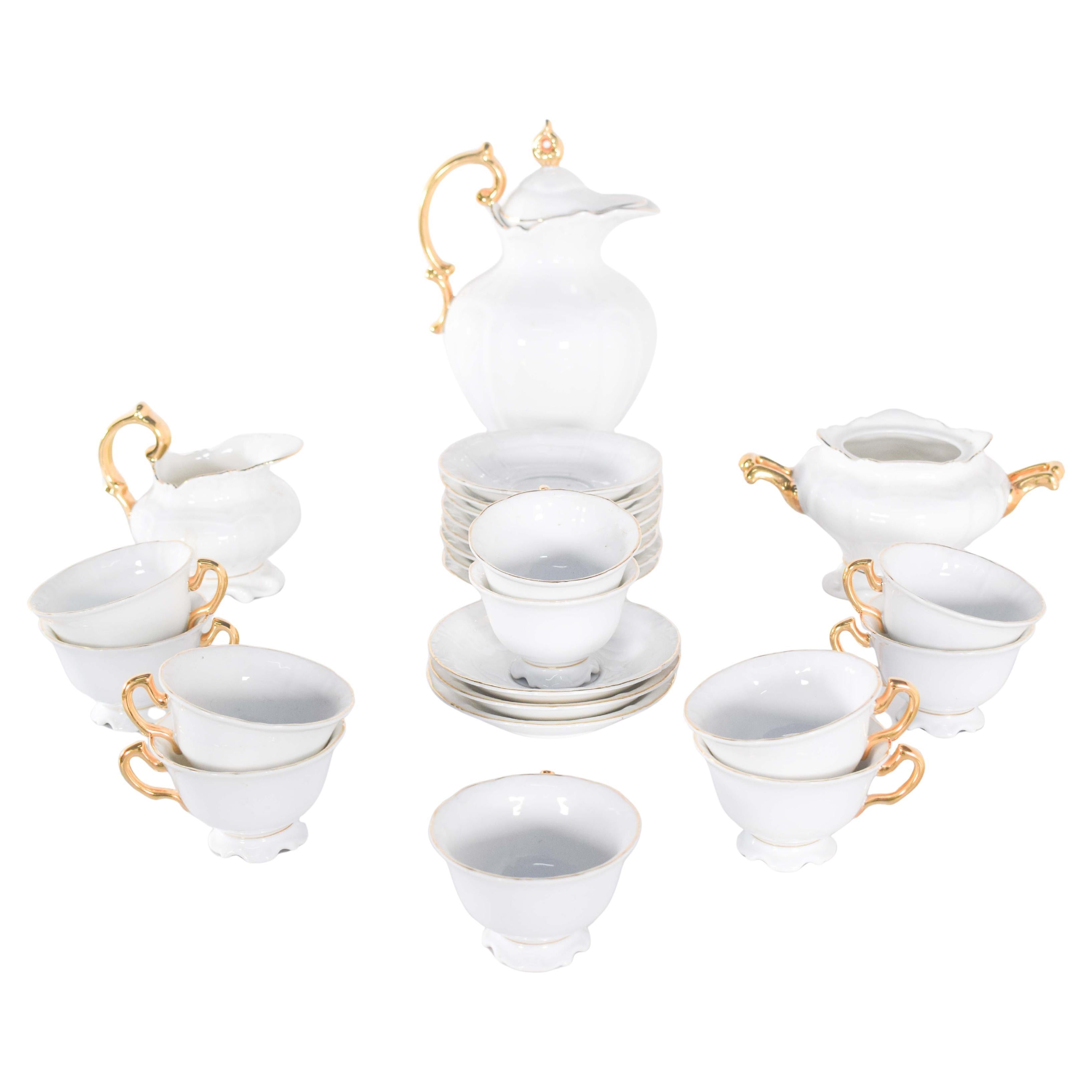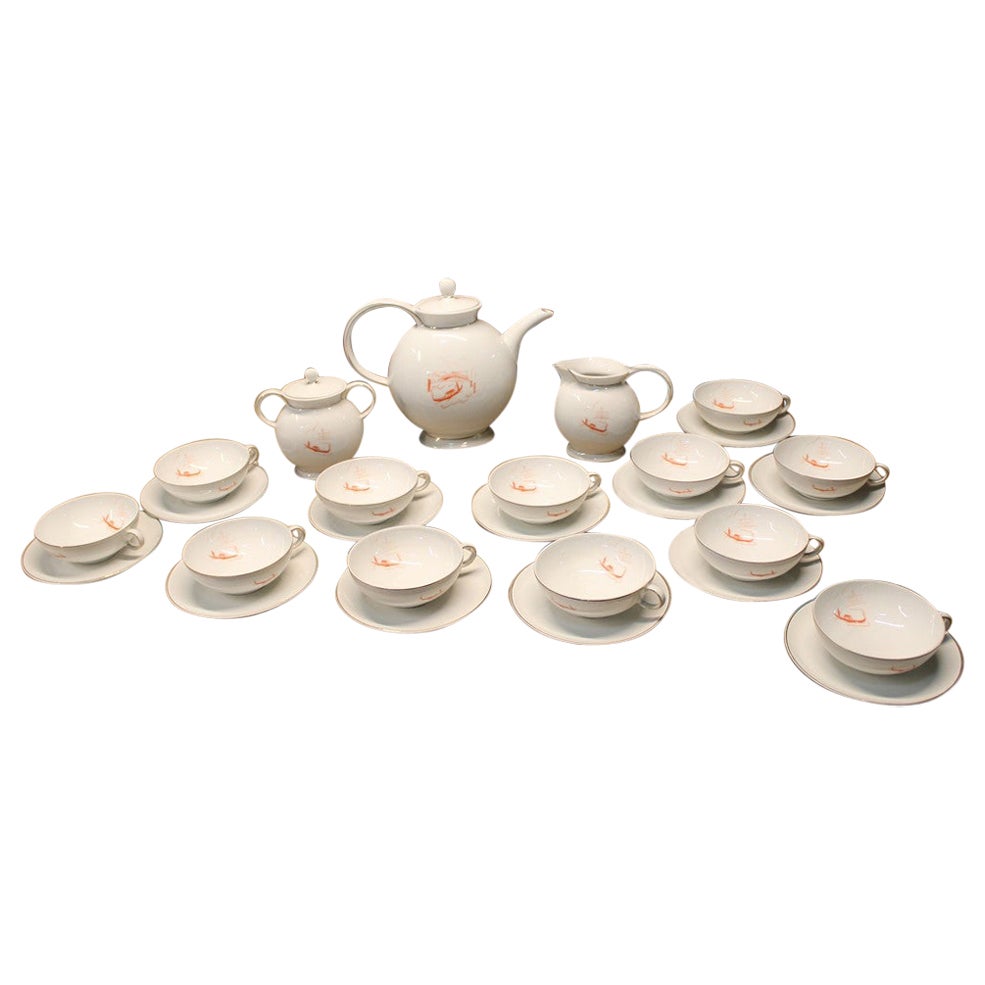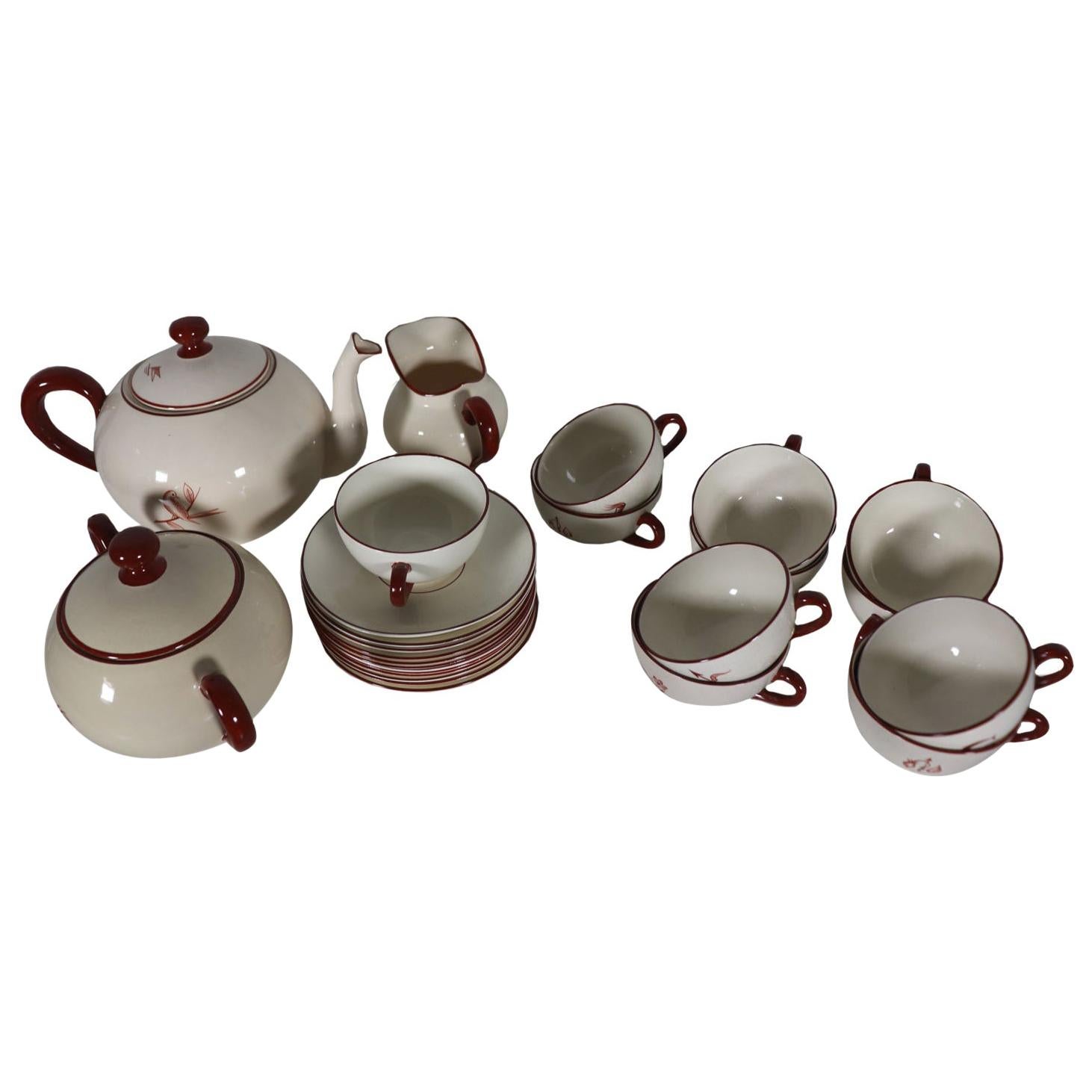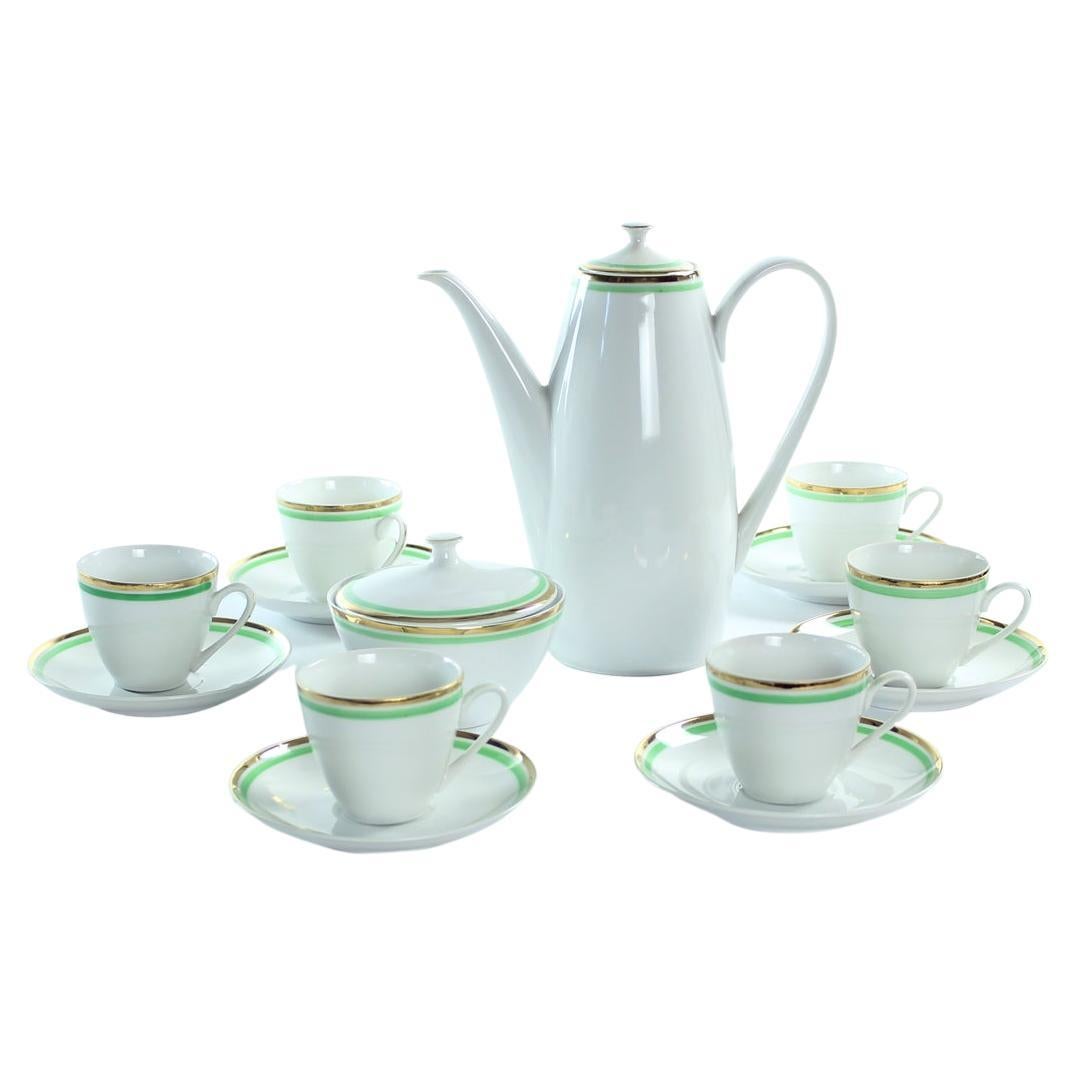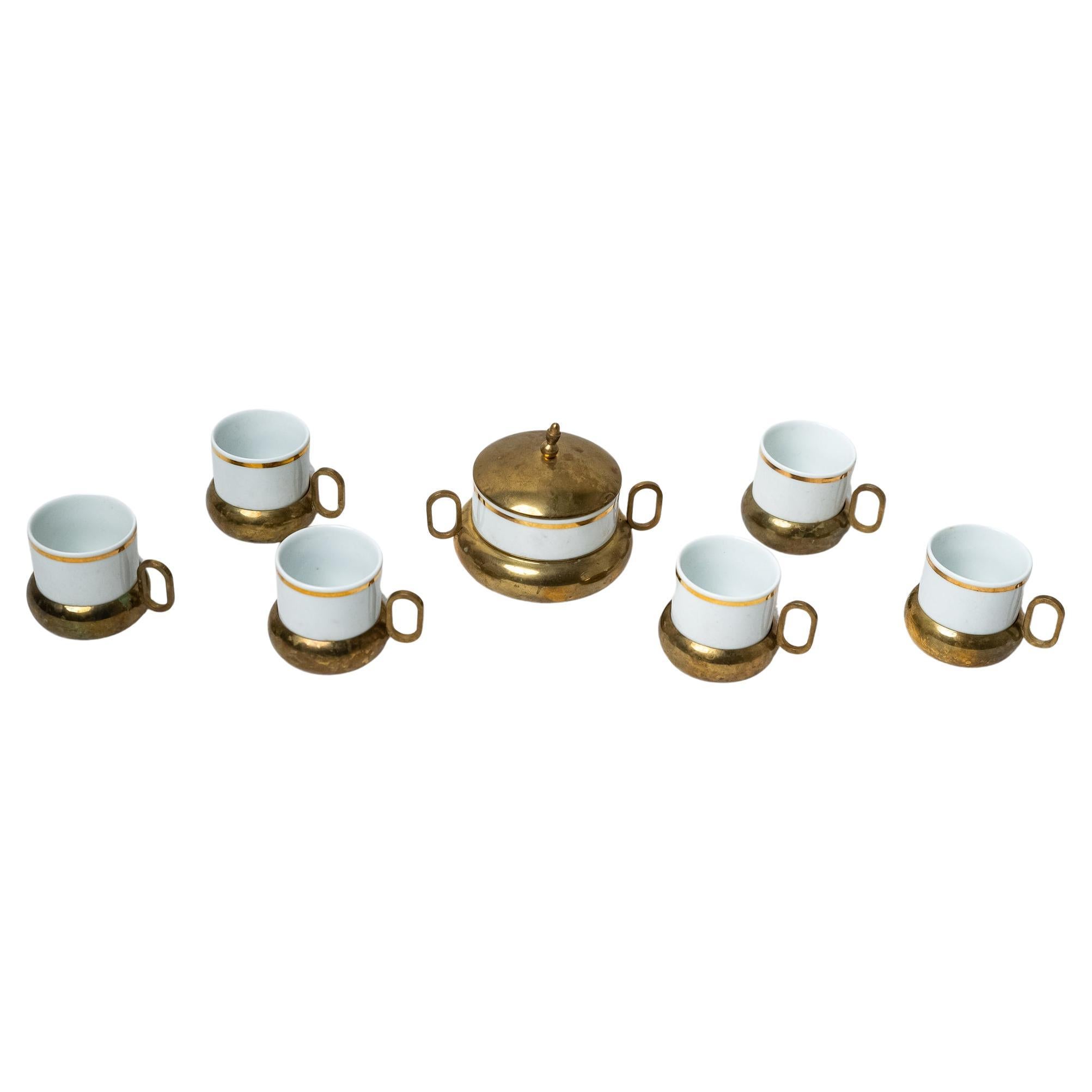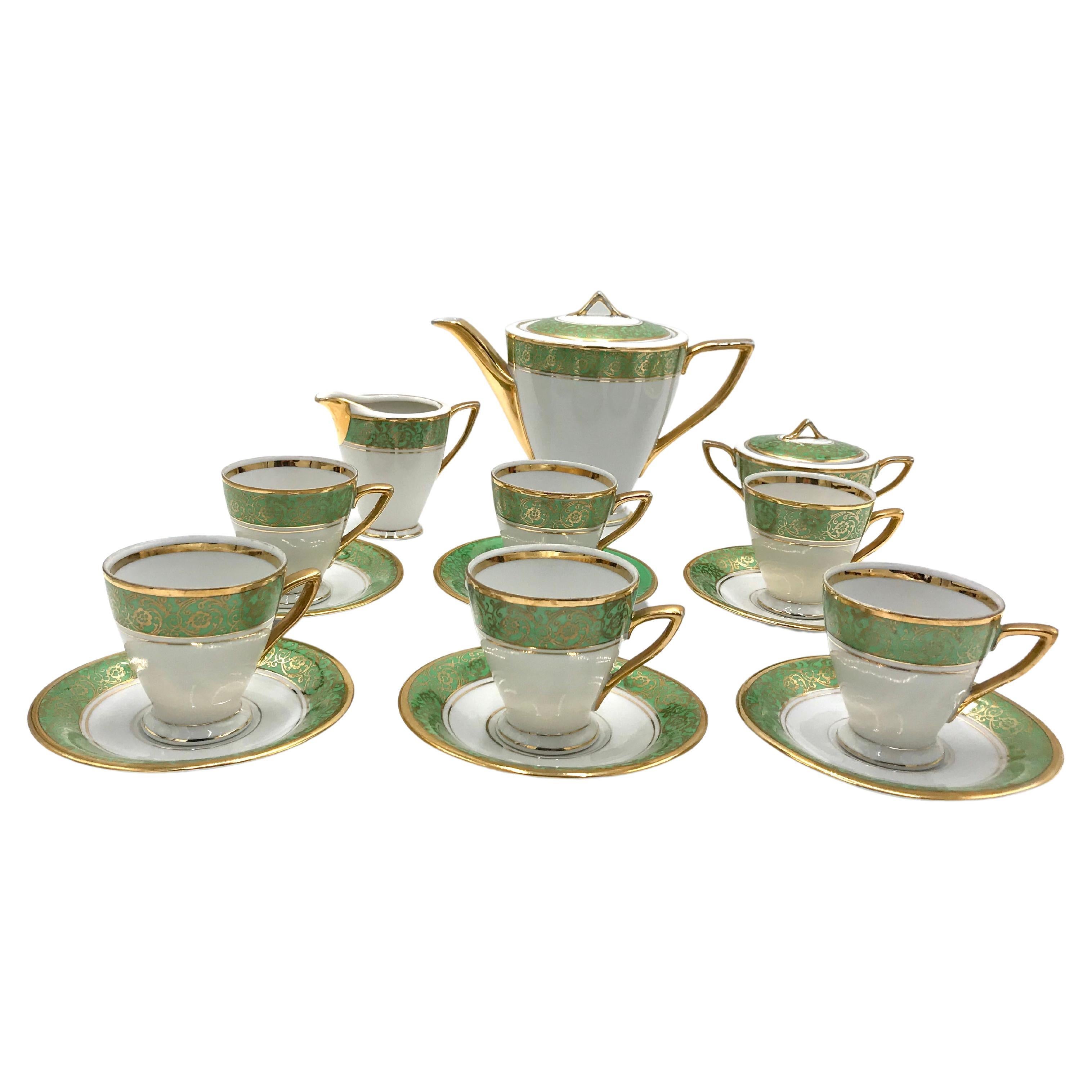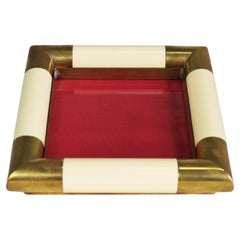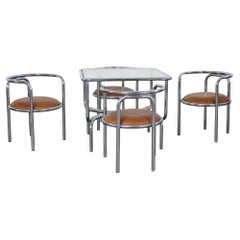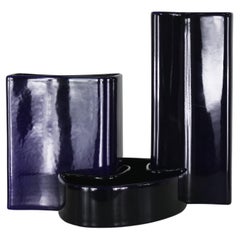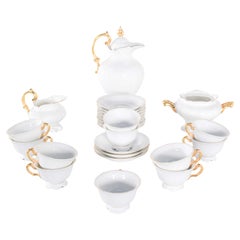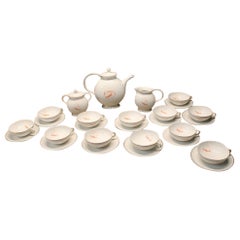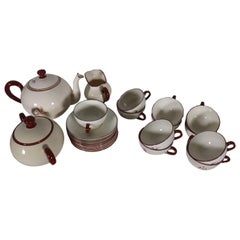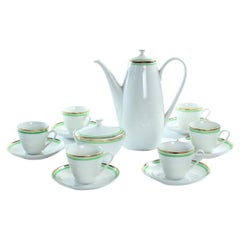Items Similar to Antonia Campi Tea Service for Six in Porcelain and Gold by Laveno 1950s
Want more images or videos?
Request additional images or videos from the seller
1 of 16
Antonia Campi Tea Service for Six in Porcelain and Gold by Laveno 1950s
$2,407.29
£1,751.28
€2,000
CA$3,285.26
A$3,658.44
CHF 1,904.01
MX$45,108.09
NOK 24,249.08
SEK 22,791.78
DKK 15,220.93
Shipping
Retrieving quote...The 1stDibs Promise:
Authenticity Guarantee,
Money-Back Guarantee,
24-Hour Cancellation
About the Item
Rare ceramic tea service for six in a very elegant light blue shade with decoration refined in pure gold, it was designed by Antonia Campi and manufactured by Laveno Ceramica in Verbano during the early 1950s.
This set is composed of six (6) teacups, six (6) tea saucers, one (1) sugar bowl, one (1) teapot, and one (1) milk jug.
Measurements:
-Six cups 6 x 8 x 5.5 cm (each)
-Sugar bowl 9 x 12 x 7 cm
-Teapot 19 x 16, 5 x 9.5 cm
-Milk Jug 11 x 12 x 7 cm.
In 1856 Carlo Caspani, Alessandro Carnelli, and Severino Revelli, three employees of the Richard Ginori ceramics factory in Milano, set up the Società Ceramica C.C.R. making use of a disused building that had been a glass factory near the lakeshore. Production mainly consisted in fine earthenware and fire bricks.
One of the key choices for the success of this initiative was an industrial-scale production of low-cost earthenware for domestic use.
The manufacture of Laveno was gaining reputation; so that in 1869 part of its activity had to be moved to a new building called “Lago”.
In 1883 it adopted a new denomination, Società Ceramica Italiana (with an S.C.I. trademark) that was to become famous.
During this period, S.C.I. was led by bright managers: Tommaso Bossi and his successor Luciano Scotti, a graduate in engineering who led the company all the time from 1895 to 1956, raising it to its top level of capacity and production.
In 1925 the Mulini plant was built in the Boesio area, where the blends and ''bodies'' were prepared. The Magazzini Generali (a warehouse), were also built and directly connected to the railway network. All the factory sites were interconnected by a “Decauville” railway for transporting materials. Also in 1925 the Verbano plant was built, following an agreement with the German Rosenthal company, for producing porcelain tableware and, later, ceramic insulators.
The drive for innovation in production technologies, that took place during the Twenties, was accompanied by an equally intense artistic development. During the twenty's the architect Piero Portaluppi started collaborating with S.C.I. and thanks to Luciano Scotti’s foresight, young Guido Andlovitz, who had entered the company in 1923, was appointed art director in 1925, who introduced a renewal in the style of shapes and decorations, so that towards the end of the 1920s Ceramica di Laveno competed with Richard-Ginori, for the leading position in the ceramic art of Italy.
Near the end of the 1930s, collaboration was started with Angelo Biancini, who created a new product line of artisan taste.
In the late Forties, the young Antonia Campi joins the company as a decoration worker. Immediately, Guido Andlovitz notes her ability and potential qualities, and moves her into the artistic department. Starting with her 1948 first tiny vase, she designs hundreds of objects of extraordinary artistic value and innovative character in less than a decade, becoming one of the best-known ceramic designers.
In 1950 the first continuous fuel oil fired kiln for production of porcelain was started in the same time, a new plant (named “Ponte”) was built and dedicated to large-scale production of stoneware objects for home use.
Stoneware production was the main division in the Società Ceramica Italiana di Laveno, the technical updating has supported by a company research department and by the well-trained workers prepared by an internal formation school, established to provide S.C.I. workers a technical and practical training that allowed them to specialize in the ceramics craft.
Beyond the Studies Center Studi and the Formation School, a planning department gathered artists and designers under the skilled guidance of Guido Andlovitz and then Antonia Campi, to develop aesthetic research on shapes and decorations, leading to creation of valuable artistic ceramic objects.
- Creator:Antonia Campi (Designer),S.C.I. Laveno (Manufacturer)
- Dimensions:Height: 7.49 in (19 cm)Width: 6.5 in (16.5 cm)Depth: 3.75 in (9.5 cm)
- Style:Mid-Century Modern (Of the Period)
- Materials and Techniques:
- Place of Origin:
- Period:
- Date of Manufacture:1950s
- Condition:Wear consistent with age and use.
- Seller Location:Montecatini Terme, IT
- Reference Number:1stDibs: LU5304222658362
About the Seller
4.9
Vetted Professional Seller
Every seller passes strict standards for authenticity and reliability
1stDibs seller since 2020
123 sales on 1stDibs
Typical response time: 1 hour
- ShippingRetrieving quote...Shipping from: Florence, Italy
- Return Policy
Authenticity Guarantee
In the unlikely event there’s an issue with an item’s authenticity, contact us within 1 year for a full refund. DetailsMoney-Back Guarantee
If your item is not as described, is damaged in transit, or does not arrive, contact us within 7 days for a full refund. Details24-Hour Cancellation
You have a 24-hour grace period in which to reconsider your purchase, with no questions asked.Vetted Professional Sellers
Our world-class sellers must adhere to strict standards for service and quality, maintaining the integrity of our listings.Price-Match Guarantee
If you find that a seller listed the same item for a lower price elsewhere, we’ll match it.Trusted Global Delivery
Our best-in-class carrier network provides specialized shipping options worldwide, including custom delivery.More From This Seller
View AllGio Ponti Set of Six Cups in Silver Alpacca for Fratelli Calderoni 1950
By Calderoni, Gio Ponti
Located in Montecatini Terme, IT
Set of six cups in silver alpaca designed by Gio Ponti for Fratelli Calderoni, 1950s.
Manufacturer's brand stamped on the bottom.
Sizes 4 x 9 cm each.
Category
Vintage 1950s Italian Mid-Century Modern Platters and Serveware
Materials
Alpaca
Tommaso Barbi Decorative Vide Poche in Brass Italian Manufacture 1970s
By Tommaso Barbi
Located in Montecatini Terme, IT
Vide Poche with structure in brass with decorative inserts in resin, the center part is in glass and shows the base underneath covered in red velvet.
This decorative piece was design...
Category
Vintage 1970s Italian Mid-Century Modern Decorative Dishes and Vide-Poche
Materials
Brass
$577 Sale Price
20% Off
Gae Aulenti Locus Solus Dining Room Set in Steel and Leather by Poltronova 1970s
By Poltronova, Gae Aulenti
Located in Montecatini Terme, IT
Locus Solus set is composed of four chairs with a structure in tubular steel a seat in padded leather and a table with a frame in tubular steel and a glass table top.
The Locus Sol...
Category
Vintage 1960s Italian Mid-Century Modern Dining Room Sets
Materials
Metal, Steel
Angelo Mangiarotti Set of Three Ceramic Vases by Fratelli Brambilla 1960s
By Angelo Mangiarotti, Fratelli Brambilla
Located in Montecatini Terme, IT
A set of three vases in blue enameled ceramic, designed by Angelo Mangiarotti and produced by Fratelli Brambilla in the 1960s.
The vases can be used singularly or as a beautiful com...
Category
Vintage 1960s Italian Mid-Century Modern Vases
Materials
Ceramic
Gianfranco Frattini Set of Four 780/783 Stacking Low Tables by Cassina 1960s
By Gianfranco Frattini, Cassina
Located in Montecatini Terme, IT
Very rare set of four low tables round-shaped, model 780/783 with a black lacquered wooden frame with a reversible top in black and white plastic laminate, designed by Gianfranco Frattini and manufactured by Cassina in 1960s.
The tables present different heights so it can be possible to be stackable to form one cylindrical block.
Frattini was born in Padova in 1926, he graduated in Architecture at the Politecnico di Milano in 1953, where he opened his first professional studio after working in Gio Ponti’s studio, his master and mentor. He worked in the field of architecture and design, with a particular interest in interior design, and attended many exhibitions and events. In 1956 he was between the founders of ADI (Association for Industrial Design) for which he created several pieces.
His creations range from furnishing to lamps, marked by an essential and rigorous style. Wood was undoubtedly his preferred material, he knew its features and crafted it passionately. Among his best sellers, the 780/783 set of stacking tables for Cassina, the Sesann armchair for Tacchini, the Albero bookcase...
Category
Vintage 1960s Italian Mid-Century Modern Coffee and Cocktail Tables
Materials
Plastic, Laminate, Beech
$4,814 Sale Price / set
42% Off
Giovanni Michelucci Dining Room Set with Table Bench and Chairs by Poltronova
By Poltronova, Giovanni Michelucci
Located in Montecatini Terme, IT
Torbecchia dining room set is composed of four chairs, one table, and one bench.
The table and the bench were made in walnut wood, the chairs have a structure in walnut wood and wove...
Category
Vintage 1960s Italian Mid-Century Modern Dining Room Sets
Materials
Straw, Walnut
You May Also Like
Coffee Set in Vista Alegre Porcelain, Portugal
By Vista Alegre
Located in Lisboa, Lisboa
Incomplete coffee service, in Vista Alegre porcelain, consisting of a teapot, milk jug, sugar bowl, ten saucers and eleven cups. Decorated in gold on white on the handles and lid of ...
Category
Mid-20th Century Portuguese Mid-Century Modern Tea Sets
Materials
Porcelain
Italian Tea Service Guido Andlovitz Italy 1940s with Venice and Gondolas Laveno
By Guido Andloviz
Located in Palermo, Sicily
Saucers diameter 14.5 cm
Cups diameter 12 cm, height 4 cm
Teapot height 20 cm, width 25 cm, depth 10 cm
Sugar bowl 13 cm high, 14 cm wide, 7 cm deep.
Spout 11 cm high, 14 cm wide...
Category
Vintage 1940s Italian Mid-Century Modern Tea Sets
Materials
Porcelain
Tea Service, Richard Ginori- San Cristoforo, Milan, 1930s
By Richard-Ginori San Cristoforo, Gio Ponti
Located in Milano, IT
Decorated white porcelain tea service. Paintings are attributed to Giò Ponti, director and designer of Richard Ginori at the time. Manufacturing brand under the base. Teas service made of teapot, sugar bowl, milk jug, 12 small plates...
Category
Vintage 1930s Italian Mid-Century Modern Porcelain
Materials
Porcelain
$1,733 Sale Price / set
20% Off
Mid Centtury Porcelain Coffee Set, Czechoslovakia, 1954
Located in Zohor, SK
Beautiful mid-century porcelain set for tea or coffee serving. Original porcelain made in Czechoslovakia in 1954. The set is stamped with original stamp on each piece by Bohemia porc...
Category
Vintage 1950s Czech Mid-Century Modern Tea Sets
Materials
Gold
$456 Sale Price / set
50% Off
Porcelain and Brass Coffee Set, First Half of the 1900s
Located in Bastia Umbra, IT
Porcelain and Brass Coffee Set, Made in Italy, First half of the 1900s.
Very rare porcelain service consisting of 6 cups, made of porcelain and brass, and 1 sugar bowl made of porce...
Category
Vintage 1910s Italian Mid-Century Modern Porcelain
Materials
Brass
Karolina Porcelain Coffee Service, Poland, 1950s / 1960s
Located in Chorzów, PL
Porcelain coffee set, a rare design of the Karolina set from the mid-twentieth century.
The service includes a jug, milk jug, sugar bowl, 6 cups and 6 saucers. One saucer has more...
Category
Vintage 1950s Polish Mid-Century Modern Porcelain
Materials
Porcelain
$337 Sale Price / set
20% Off
